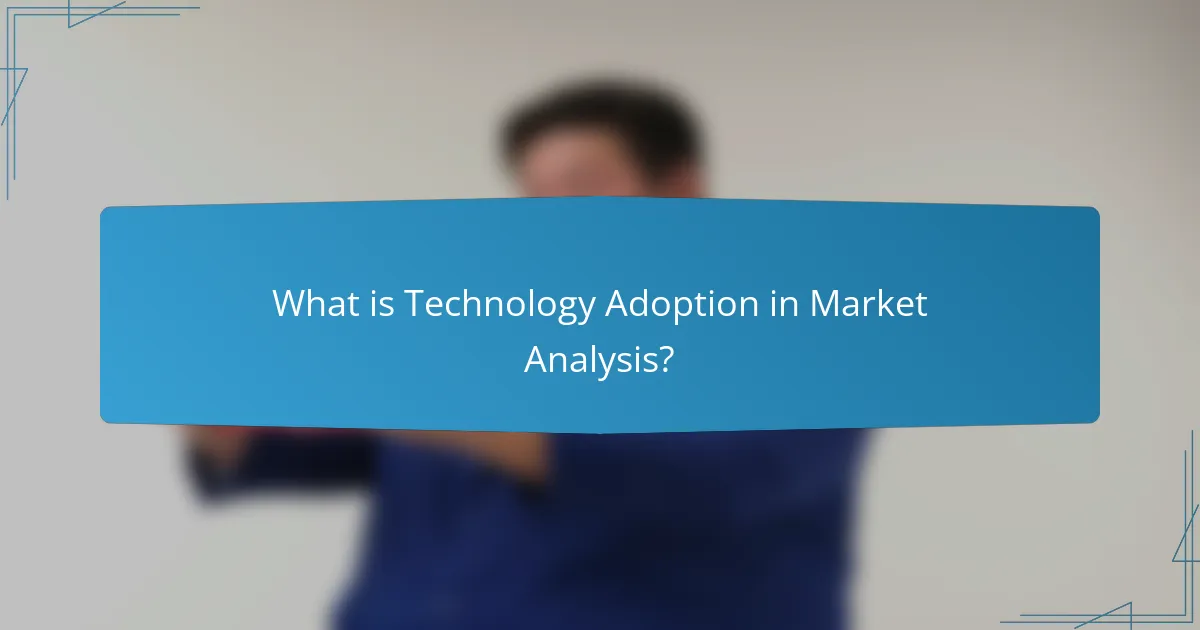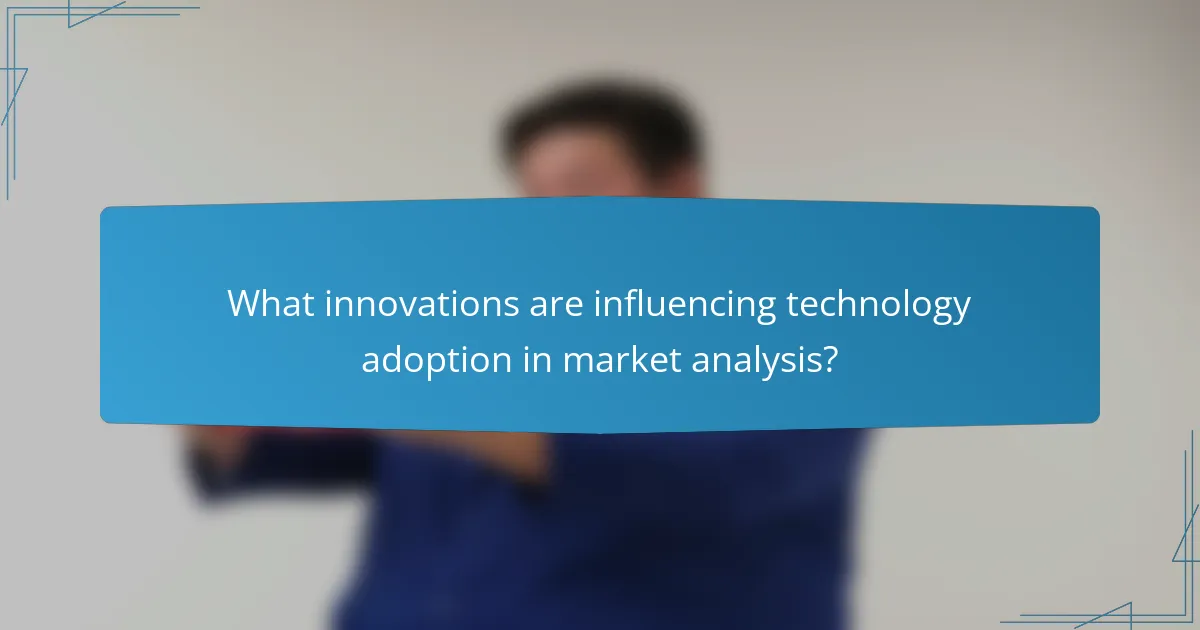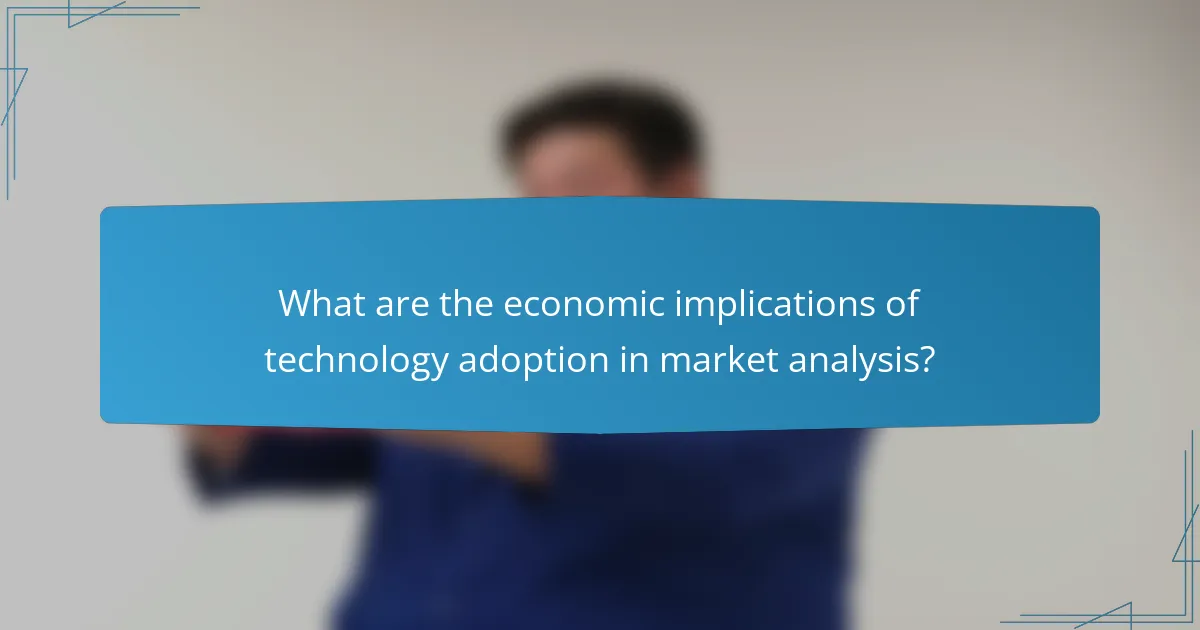Technology adoption in market analysis refers to how consumers and businesses accept and utilize new technologies, significantly influencing market dynamics and consumer behavior. Key factors in this process include perceived benefits, ease of use, and compatibility with existing systems, with frameworks like the Technology Adoption Life Cycle categorizing adopters into groups such as innovators and laggards. Innovations such as artificial intelligence, big data analytics, and machine learning enhance data processing and predictive modeling, driving efficiency in market analysis. The economic implications of technology adoption are profound, leading to increased productivity, improved decision-making, and enhanced competitiveness for businesses.

What is Technology Adoption in Market Analysis?
Technology adoption in market analysis refers to the process by which consumers and businesses accept and utilize new technologies. This process is critical for understanding market dynamics and consumer behavior. It involves evaluating factors such as perceived benefits, ease of use, and compatibility with existing systems. Market analysts use frameworks like the Technology Adoption Life Cycle to categorize adopters into groups such as innovators, early adopters, and laggards. These categorizations help in forecasting market trends and potential revenue impacts. Studies show that successful technology adoption can lead to increased efficiency and competitive advantage for businesses. For instance, a report by McKinsey & Company indicates that companies that embrace new technologies can improve productivity by up to 20%.
How does technology adoption impact market analysis?
Technology adoption significantly enhances market analysis by providing advanced tools and methodologies. These tools enable more accurate data collection and analysis. For instance, big data analytics allows businesses to process vast amounts of information quickly. This results in better insights into consumer behavior and market trends. Additionally, technologies like artificial intelligence improve predictive analytics. They help in forecasting market movements with greater precision. A report by McKinsey & Company highlights that companies using advanced analytics outperform their competitors by 20%. Overall, technology adoption leads to more informed decision-making and strategic planning in market analysis.
What are the key stages of technology adoption in market analysis?
The key stages of technology adoption in market analysis are awareness, interest, evaluation, trial, and adoption. Awareness is when potential users first learn about a new technology. Interest follows, where users seek more information and consider its relevance to their needs. Evaluation occurs as users assess the technology’s benefits and drawbacks. Trial involves testing the technology in a limited capacity to gauge its effectiveness. Finally, adoption is when users fully integrate the technology into their operations. These stages reflect the process through which individuals and organizations transition from unfamiliarity to acceptance of new technologies.
How do different industries approach technology adoption in market analysis?
Different industries adopt technology in market analysis based on their specific needs and operational contexts. For instance, the retail sector often utilizes advanced analytics and AI to optimize inventory and enhance customer experience. In contrast, the healthcare industry focuses on adopting technologies that improve patient outcomes and streamline operations, such as electronic health records and telemedicine. The financial services sector frequently integrates fintech solutions for better risk assessment and customer service efficiency.
Each industry’s approach is influenced by regulatory requirements, competitive pressures, and the need for innovation. For example, the automotive industry invests in data analytics for predictive maintenance and autonomous driving technologies. According to a report by McKinsey, companies that effectively adopt technology can increase their productivity by up to 30%. This highlights the significance of tailored technology adoption strategies across various sectors.
Why is understanding technology adoption important for businesses?
Understanding technology adoption is crucial for businesses because it directly impacts their competitiveness and growth. Technology adoption influences operational efficiency and productivity. According to a McKinsey report, companies that effectively adopt new technologies can improve their productivity by up to 20%. It also enables businesses to meet customer expectations and enhance user experience. The rapid pace of technological change means that staying updated is essential. Firms that lag in technology adoption risk losing market share to more agile competitors. Additionally, understanding technology adoption helps businesses make informed investment decisions. This knowledge allows for better resource allocation and strategic planning.
What are the potential risks of not adopting new technologies in market analysis?
The potential risks of not adopting new technologies in market analysis include reduced competitiveness and missed market opportunities. Companies may fall behind rivals that utilize advanced analytics for decision-making. This can lead to outdated strategies that do not align with current consumer behaviors. Additionally, businesses may struggle to interpret large data sets effectively without modern tools. Inefficient processes can result in higher operational costs and slower response times to market changes. According to a study by McKinsey, companies that leverage data-driven decision-making are 23 times more likely to acquire customers. Failure to adopt new technologies could also lead to poor customer insights, impacting overall satisfaction and retention.
How can technology adoption drive competitive advantage?
Technology adoption can drive competitive advantage by enhancing operational efficiency and enabling innovation. Companies that integrate advanced technologies often streamline processes and reduce costs. For instance, automation can improve production speed and accuracy. Furthermore, data analytics allows businesses to make informed decisions quickly. According to a McKinsey report, organizations that adopt digital technologies can increase productivity by up to 20-30%. This leads to improved customer satisfaction and retention. Additionally, technology adoption fosters adaptability in rapidly changing markets. Firms that leverage new tools can respond to consumer demands more effectively. Thus, technology adoption is crucial for maintaining a competitive edge in today’s economy.

What innovations are influencing technology adoption in market analysis?
Innovations influencing technology adoption in market analysis include artificial intelligence, big data analytics, and machine learning. Artificial intelligence enhances data processing and predictive modeling. Big data analytics allows for the analysis of vast datasets to uncover trends. Machine learning algorithms improve the accuracy of forecasts and insights. Cloud computing enables scalable solutions for data storage and access. Mobile technology facilitates real-time data collection and reporting. Blockchain offers secure transaction methods and transparency in data sharing. These innovations collectively drive efficiency and accuracy in market analysis.
Which technologies are currently reshaping market analysis?
Artificial intelligence (AI) and machine learning (ML) are currently reshaping market analysis. These technologies enable businesses to analyze vast amounts of data quickly and accurately. AI algorithms can identify patterns and trends that human analysts might overlook. Machine learning models improve over time, enhancing predictive accuracy. Natural language processing (NLP) is also significant. NLP allows for sentiment analysis from customer feedback and social media. Big data analytics provides insights from diverse data sources. Cloud computing facilitates real-time data access and collaboration. These technologies collectively enhance decision-making and strategic planning in market analysis.
How is artificial intelligence transforming market analysis practices?
Artificial intelligence is transforming market analysis practices by enhancing data processing and predictive analytics. AI algorithms can analyze vast amounts of data quickly and accurately. This capability allows businesses to identify trends and consumer behaviors more effectively. For instance, machine learning models can predict market shifts based on historical data. According to a McKinsey report, companies using AI in marketing saw a 20% increase in productivity. Additionally, AI tools streamline customer segmentation, enabling targeted marketing strategies. By automating routine tasks, AI frees analysts to focus on strategic decision-making. Overall, AI’s integration into market analysis leads to more informed business strategies and improved competitive advantage.
What role do big data and analytics play in technology adoption?
Big data and analytics are crucial for technology adoption. They provide insights that drive decision-making. Organizations leverage data to identify trends and customer preferences. This helps in tailoring technology solutions to meet market demands. Analytics enable businesses to assess the potential impact of new technologies. They can predict adoption rates and user engagement. For instance, a study by McKinsey found that data-driven organizations are 23 times more likely to acquire customers. This demonstrates the effectiveness of big data in enhancing technology adoption strategies.
How do innovations affect consumer behavior in market analysis?
Innovations significantly influence consumer behavior in market analysis by altering preferences and purchasing decisions. New technologies often lead to enhanced product features, increasing consumer interest. For example, the introduction of smartphones transformed communication habits and shopping behaviors. Studies indicate that 79% of consumers use their smartphones for product research before making a purchase. Innovations can also create new market segments, as seen with the rise of eco-friendly products appealing to environmentally conscious consumers. Furthermore, innovations can shift consumer expectations, as seen in the demand for faster delivery services driven by companies like Amazon. Overall, innovations reshape the landscape of consumer behavior, making it crucial for market analysts to adapt strategies accordingly.
What are the implications of emerging technologies on consumer preferences?
Emerging technologies significantly influence consumer preferences. They reshape how consumers interact with products and services. For instance, advancements in artificial intelligence personalize shopping experiences. This leads to increased customer satisfaction and loyalty. Additionally, mobile technology enhances convenience, allowing consumers to shop anywhere at any time. According to a 2021 McKinsey report, 70% of consumers expect personalized experiences. Moreover, social media platforms drive trends and influence purchasing decisions. A survey by Deloitte found that 47% of consumers are influenced by social media in their buying choices. Therefore, emerging technologies create a dynamic environment that continuously alters consumer behavior.
How can businesses leverage innovations to improve customer insights?
Businesses can leverage innovations to improve customer insights by utilizing advanced data analytics tools. These tools enable the collection and analysis of large volumes of customer data. Machine learning algorithms can identify patterns in customer behavior. Real-time analytics allows businesses to respond promptly to changing customer preferences. Innovations in customer relationship management (CRM) systems enhance personalized marketing efforts. For example, companies like Amazon use predictive analytics to recommend products based on past purchases. Social media monitoring tools provide insights into customer sentiment and trends. By integrating these innovations, businesses can make informed decisions that enhance customer satisfaction and loyalty.

What are the economic implications of technology adoption in market analysis?
Technology adoption in market analysis significantly impacts economic performance. It enhances data accuracy and decision-making efficiency. Businesses can analyze market trends more effectively with advanced analytical tools. This leads to better resource allocation and optimized operations. Increased technology use often results in cost reductions. According to a McKinsey report, companies that adopt digital technologies can see productivity gains of 20-30%. Additionally, technology adoption facilitates innovation, driving new product development. This can lead to increased market competitiveness and revenue growth. Overall, the economic implications are profound and far-reaching.
How does technology adoption influence market efficiency?
Technology adoption enhances market efficiency by streamlining processes and reducing costs. It allows for faster communication and information sharing among market participants. This leads to quicker decision-making and more responsive supply chains. Increased automation minimizes human error and operational delays. Data analytics improve forecasting accuracy, optimizing resource allocation. A study by Brynjolfsson and McAfee (2014) highlights that firms adopting technology see productivity gains. Overall, technology adoption fosters a competitive environment, driving innovation and efficiency in markets.
What are the economic benefits of adopting new technologies in market analysis?
Adopting new technologies in market analysis leads to increased efficiency and cost savings. Technologies such as artificial intelligence and big data analytics streamline data processing. This results in faster decision-making and reduced labor costs. Enhanced data accuracy minimizes costly errors in market predictions. Improved customer insights drive targeted marketing strategies, boosting sales. According to a report by McKinsey, companies leveraging advanced analytics can increase their profitability by 5-6%. Furthermore, technology adoption fosters innovation, allowing businesses to stay competitive in dynamic markets.
How can technology adoption lead to cost reductions in market analysis?
Technology adoption can lead to cost reductions in market analysis by automating data collection and processing tasks. Automation decreases the need for manual labor, which reduces labor costs. Advanced analytics tools can analyze large datasets quickly, providing insights faster than traditional methods. This speed allows businesses to make timely decisions, minimizing costly delays. Additionally, cloud-based solutions can lower infrastructure costs by reducing the need for on-premises hardware. According to a report by McKinsey, companies that adopt advanced analytics can improve their productivity by up to 20%. These factors collectively contribute to significant cost savings in market analysis.
What challenges do businesses face when adopting new technologies?
Businesses face several challenges when adopting new technologies. These challenges include high costs associated with implementation. Additionally, there is often resistance to change from employees. Training staff to use new technologies can be time-consuming and expensive. Integration with existing systems can also pose significant difficulties. Moreover, businesses may struggle with data security concerns related to new technologies. Keeping up with the rapid pace of technological advancements adds further pressure. Finally, measuring the return on investment can be complex and uncertain. Each of these challenges requires careful consideration and strategic planning to overcome.
How can organizations overcome barriers to technology adoption?
Organizations can overcome barriers to technology adoption by implementing strategic change management practices. These practices include effective communication of the technology’s benefits to all stakeholders. Training programs should be established to enhance user skills and confidence. Leadership support is critical in fostering a culture that embraces change. Additionally, organizations can conduct pilot programs to demonstrate the technology’s value in a controlled environment. Research shows that organizations with strong change management frameworks have higher adoption rates. For instance, a study by Prosci indicates that effective change management can improve project success rates by up to 70%.
What strategies can enhance the effectiveness of technology adoption in market analysis?
Effective strategies for enhancing technology adoption in market analysis include comprehensive training programs, stakeholder engagement, and iterative feedback mechanisms. Comprehensive training equips users with necessary skills for new technologies. Stakeholder engagement ensures alignment of technology with business goals. Iterative feedback allows continuous improvement based on user experience. Research shows that organizations with structured training see a 60% increase in technology utilization. Engaging stakeholders can lead to a 30% reduction in resistance to change. Implementing these strategies fosters a culture of innovation and drives successful technology integration in market analysis.
What best practices should businesses follow for successful technology adoption?
Businesses should follow several best practices for successful technology adoption. First, they need to assess their specific needs and goals. This ensures that the technology aligns with their strategic objectives. Second, involving stakeholders early in the process is crucial. Engaging employees can facilitate smoother transitions and foster acceptance. Third, providing comprehensive training is necessary. Educated staff can maximize the benefits of new technology. Fourth, businesses should implement a phased rollout. Gradual adoption allows for adjustments based on feedback. Lastly, continuous evaluation of technology performance is essential. Regular assessments help identify areas for improvement and ensure ongoing alignment with business objectives. These practices lead to higher success rates in technology adoption.
Technology adoption in market analysis refers to the process through which consumers and businesses accept and utilize new technologies, significantly impacting market dynamics and consumer behavior. The article explores the key stages of technology adoption, its influence across various industries, and the economic implications of adopting advanced technologies. It highlights the role of innovations such as artificial intelligence and big data analytics in enhancing decision-making and operational efficiency. Additionally, the article discusses the challenges businesses face during technology adoption and best practices for successful implementation, underscoring the importance of understanding technology adoption for maintaining competitiveness and driving growth.